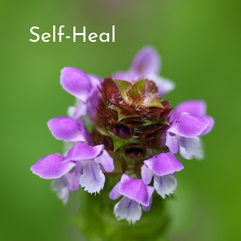Making First-Aid Salve | Herbal Remedies
- tracymartorana4
- Nov 7, 2024
- 3 min read
Herbal salves are easier to make than you might think. All you need is herbal oil and beeswax.
Homemade salve makes great stocking stuffers or teacher's gifts. So grab some basic ingredients and whip up a batch!
Supplies
Oil (such as olive oil, grapeseed oil, avocado oil, sunflower oil, or almond oil)
Beeswax pastilles
Herbs of your choice (see below for suggestions)
Essential Oils of your choice (see below for suggestions)
Small tin containers with lids
Watch Me Make It
Herb Options
There are so many herbs to choose from. I like to use ones I can grow or harvest at home, but you can also purchase herbs. This is just a highlight list, there are a ton of options. Choose herbs that you are familiar with.
*Self-Heal - I harvest this from my yard. This little flower is a powerhouse and its name says it all. It has antiseptic qualities, is astringent, reduces swelling, and is anti-inflammatory.
*Plantain - A common "weed" that I see in almost every yard I'm in. It is anti-inflammatory, promotes wound healing, and can help remove the sting from bee stings and bug bites.
*Yarrow - This is often a plant you can find in the wild, but many people grow it in their garden as well. Yarrow is antibacterial, helps control bleeding, and promotes healing.
*Calendula - This beautifully bright flower is soothing to irritated skin. It also has mild antiseptic qualities and is shown to promote wound healing.
Chamomile - This sweet-smelling flower is for more than just tea. When I'm looking for a soothing herb, whether I'm trying to calm down my digestive system or an irritated patch of skin, I instantly think of chamomile.
Lavender - Not only does lavender smell wonderful, it is both soothing and antiseptic.
Comfrey - This is a great herb for treating sprains, bruises or any injury where you see inflammation and swelling. Note: this is the only herb listed here that should never be taken internally. I know we are talking about salves in this post, but I want to be clear, this is NOT an herb you would ever add into an herbal tea blend.
St. Johns Wort - While we often think of using this herb to treat anxiety and depression, it is great for skin ailments too. It is both anti-inflammatory and antiseptic.
Note: this herb can cause photosensitivity, so if you are using St Johns Wort in a salve or skin product, be careful to avoid too much sun exposure. I would also investigate possible side effects and warnings before taking this herb internally.
*Herbs noted with an asterisk were the ones I used in the salve I made in the video above.
Disclaimers
The information provided is not intended to be a substitute for medical treatment. Please be sure to research herbs and consult your medical care provider before using herbal medicine, particularly if you have a known medical condition or if you are pregnant or nursing. The information provided should not be considered healthy advice. You are responsible for consulting a medical professional before implementing a new herb or herbal remedy. Allergic reactions and interactions with prescription and over-the-counter medications can occur and can be serious.
If you choose to grow or wild harvest herbs do your homework to be sure you have the herb you think you do. There are many look-alike plants. When in doubt, source from a reputable herb shop.
Finally, First-Aid Salves are meant to treat minor injuries such as scrapes, bruises, bug bites, minor burns, etc. If you have a deep wound, excessive bleeding, a 2nd or 3rd degree burn, or a large area of skin affected, seek medical attention.
Essential Oil Options
If you want to add scent and additional healing/soothing power, add a few drops of essential oil. Choose something soothing and pleasant such as Lavender oil or Chamomile oil.
Instructions
Make your herbal oil by infusing the herbs in the oil under low heat. If the heat is too high, you end up frying your herbs and that's not your goal.
Strain the herbs from the oil.
Heat the oil again. Add the beeswax pastilles. Heat until melted. (4 parts oil to 1 part beeswax)
Test out the consistency. Dip the spoon into the salve, and place ii in the refrigerator to cool. Check firmness. If it's too soft, add a little more beeswax. If it seems too hard, add a little more oil.
Add the essential oil.
Pour into tin containers and allow to cool.
Make some pretty labels. Include all ingredients used, especially if you are giving it as a gift.
Pin It For Later























Comments